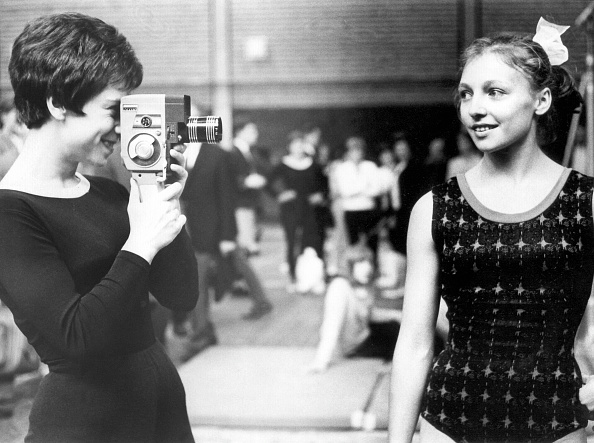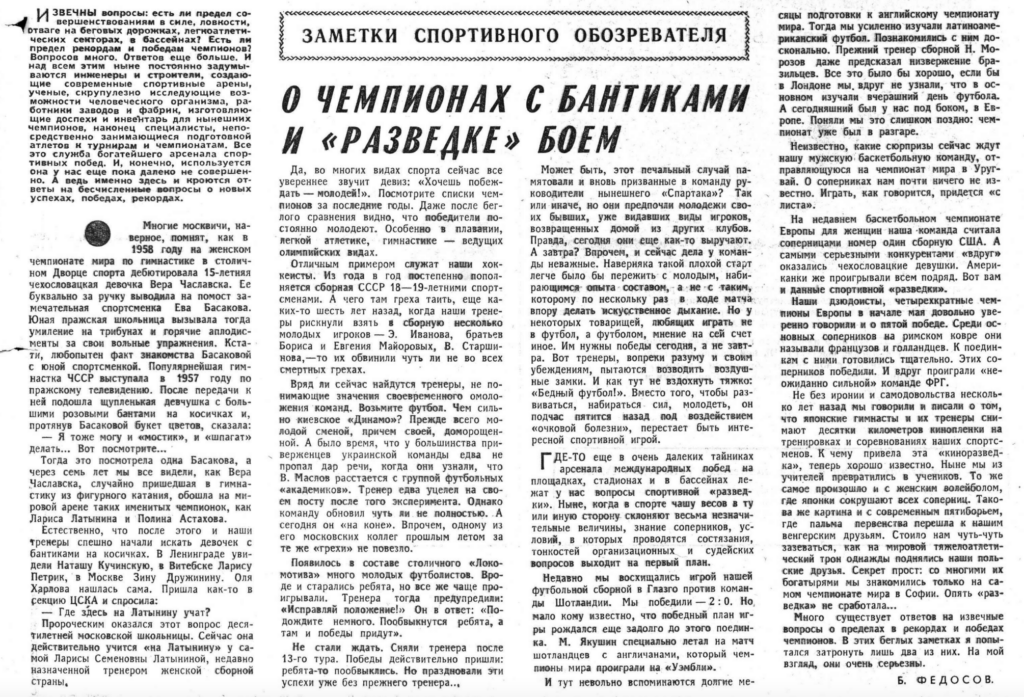While Olga Korbut and Nadia Comăneci are often credited with ushering in the era of teenage gymnasts, that’s not the origin story that circulated in the Soviet Union in the 1960s.
Back story: The Soviet Union had relied on adult women in their 20s and 30s for their gymnastics teams. At the 1958 World Championships, their youngest gymnasts were 21 (Astakhova and Kalinina). Czechoslovakia, on the other hand, brought a teenager who had star power.
Čáslavská’s debut: In 1958, 16-year-old Věra Čáslavská made her international debut, winning a team silver at the World Championships in Moscow. And, as the tale goes, it was in that moment that the Čáslavská piqued the interest of the spectators and Soviet coaches alike.
What follows is a translation of a May 20, 1967 article from Неделя (Nedelia), which was the Sunday supplement to Известия (Izvestii︠a︡). (Thanks to Nico for his assistance with the translation.)
Many Muscovites, for sure, remember how, in 1958, the 15-year-old* Czechoslovak girl Věra Čáslavská made her debut at the World Championships in the capital’s Sports Palace. She was literally escorted to the platform by the hand of the wonderful athlete Eva Bosáková. The young Prague schoolgirl then evoked affection in the stands and warm applause for her floor routines. By the way, the fact of Bosáková’s acquaintance with the young athlete is curious. The most popular gymnast of Czechoslovakia performed on Prague television in 1957. After the program, a puny little girl with big pink bows on her pigtails came up to her and, holding out a bouquet of flowers, said to Bosáková:
– I can do a bridge and the splits … Look here …
Bosáková alone saw it then, and seven years later [in 1964], we all saw how Věra Čáslavská, who accidentally came to gymnastics from figure skating, bypassed famous champions such as Larisa Latynina and Polina Astakhova on the world stage.

Naturally, after that, our coaches hastily began to look for girls with bows on their pigtails. In Leningrad, they saw Natasha Kuchinskaya; in Vitebsk, Larisa Petrik; and in Moscow, Zinaida Druzhinina. Olga Kharlova found herself. Once she came to the CSKA section and asked:
– Is this where they train to become Latynina?
This question from a ten-year-old Moscow schoolgirl turned out to be prophetic. Now she is really learning to become Latynina from Larisa Semyonovna Latynina herself, who was recently appointed coach of the country’s women’s national team.
Yes, in many sports nowadays the motto sounds more and more confident: “If you want to win — young people!”
[The article continues on, talking mostly about non-gymnastics sports.]
*Čáslavská was 16 at the 1958 World Championships, but birthdates weren’t as readily available back then. If you read old newspaper articles, the writers often got the ages wrong.
To be clear, that’s not exactly how Čáslavská tells her own story. In her book, she writes:
In the winter of 1957, I had my first television appearance with Boris Milec’s school. It was a program for children, and coincidentally the gymnastics champion Eva Bosáková also performed there. I was thrilled with her performance. Since there was a long break between the rehearsal and the live broadcast, my mom brought plum cakes. She also shared them with my friends and offered them to Mrs. Bosáková, who was standing nearby. She liked them very much. They conversed a bit about some female topics. My mother, perhaps with a sixth sense, sensed that gymnastics might be the right sport for me, so she asked Eva Bosáková if she would take a look at me.
Mrs. Bosáková tested me first on the floor and then on the balance beam. I practiced on it for the first time in my life; if I hadn’t seen Eva Bosáková’s routine a while ago, I wouldn’t even know what was being practiced on it. So I tried the same thing and was shaking like an aspen. The coach laughed a lot and said to my mother:
“Mrs. Čáslavská, that girl of yours is a crazy one! Bring her to the gym with me sometime, she could be great! I train every day at the YMCA on Poříčí.”
Čáslavská, Cesta na Olymp
V zimě 1957 jsem se školou Borise Milce měla první televizní vystoupení. Šlo o pořad pro děti a shodou okolností tam vystupovala i mistryně v gymnastice Eva Bosáková. Byla jsem jejím cvičením nadšená. Protože mezi zkouškou a přímým vysíláním byla dlouhá pauza, přinesla maminka švestkové koláče. Podělila i mé kamarádky a dovolila si nabídnout i paní Bosákové, která stála poblíž. Moc jí chutnaly. Daly se s maminkou do řeči na nějaké ženské téma. Maminka snad šestým smyslem vytušila, že by sportovní gymnastika mohla být pro mne tím pravým sportem, poprosila proto Evu Bosákovou, jestli by se na mě nepodívala.
Paní Bosáková mne vyzkoušela nejdřív na zemi a potom i na kladině. Poprvé v životě jsem na ní cvičila; kdybych před chvílí neviděla sestavu Evy Bosákové, ani bych nevěděla, co se na ní cvičí. Zkoušela jsem tedy totéž a třepetala se jako osika. Poradkyně se moc smála a povídá mamince:
“Paní Čáslavská, ta vaše holka je strašný číslo! Přiveďte ji někdy za mnou do tělocvičny, mohlo by z ní něco bejt! Cvičím každej den na Poříčí v Ymce.”
So, don’t take this article as the gospel truth. Accuracy is never the goal of origin stories and lore.
Rather, consider it a story that was circulating in Moscow in the late 1960s. It offered one explanation for why the Soviet Union switched its focus from adult gymnasts to teenagers. (We’ll return to this subject in future posts.)
But it does make you think: Why have we started the history of teenage gymnasts with Korbut and Comăneci? Should the rise of prominent teenage gymnasts in the post-WWII era start with Čáslavská in the 1950s? Or with someone else? If history is a matter of perspective, whose perspective have we been telling?
🤔
In my next post, we’ll look at the performances of the Soviet Union’s teenage gymnasts at the 1966 World Championships, and we’ll discuss the Soviet Union’s phased approach to ushering in new talent and saying goodbye to their stalwarts like Latynina and Astahkova.
